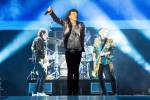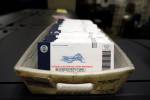Outdoor Briefs
GIZZARD SHAD IS HERE
Another new species
settles in Lake Mead
Anglers hoping to net a few threadfin shad to use as bait when fishing for Lake Mead's striped bass have been finding more than they bargained for. In addition to catching threadfin shad, anglers also have been catching something different, something new. According to the Nevada Department of Wildlife, what anglers are finding in their nets is the gizzard shad, a species of fish that is new to the Lower Colorado River System.
Native to the eastern half of the United States, gizzard shad are now found in several western waters. It's believed the fish arrived in the Colorado River basin from an accidental introduction into New Mexico's San Juan River. Gizzard shad were first discovered in Lake Mead's Greggs Basin in 2007, the same year quagga mussels were found in the Lower Colorado River.
"We believe the gizzard shad in Lake Mead came from Lake Powell through the Colorado River. During a fish sampling project in August 2009, we found the first indication that gizzard shad are now reproducing naturally in Lake Mead and are probably doing so lake wide," said Jon Sjoberg, NDOW Southern Region fisheries supervisor.
During recently completed studies at Lake Mead, NDOW fisheries biologists found that 58 percent of the catch was comprised of gizzard shad, which accounted for 44 percent of the biomass in that survey. In addition, "the average body condition of striped bass is probably the best we've ever seen. So the stripers are currently benefiting from the gizzard shad's presence," Sjoberg said.
Gizzard shad are an important forage fish for various bass species. They are filter feeders that spend most of their lives consuming phytoplankton and insects. Their preferred habitat generally consists of silty, sandy areas in lakes and rivers because they require sand in their diet. Gizzard shad grow very rapidly and can reach lengths up to 20 inches, though they average between nine and 14 inches. During the spring spawning period, female gizzard shad can lay more than 350,000 eggs.
Since long before the gizzard shad's arrival, the primary forage fish in Lake Mead has been the threadfin shad. They were first introduced into Lake Mead by NDOW in the mid-1950s through a federal aid program with U.S. Fish and Wildlife Service and have been the main food source for largemouth bass and striped bass. The silvery threadfin shad rarely exceeds six inches in length, is also a filter feeder and feeds primarily on plankton. Spawning occurs in the spring with females laying up to 22,000 eggs, significantly less than the gizzard shad.
So, what happens to the threadfin shad population now that the gizzards have moved in? That's the question biologists are asking, especially since both fish species depend on the same food source. Gizzard shad grow more rapidly and up to three times larger than the threadfin variety, but they feed primarily on the bottom and in coves where it is sandy and silty. Threadfin shad, on the other hand, prefer open water throughout their entire life cycle. "We're hopeful that there will be little forage competition between the gizzard shad and threadfin shad due to the different habitat preferences," Sjoberg said.
What about the sport fish in the reservoir?
Largemouth bass are ambush predators that wait in the rocky and weedy structure of the lake for shad to swim by.
Stripers school and trap the shad against the surface of the water where they thrash to stun and eventually eat the shad. While both shad species will provide the various bass species with a food source, gizzard shad can very rapidly grow too large for largemouth bass and smaller stripers to consume. That occurs when the shad grow beyond seven inches in length, and due to their fast growth rates, that happens quickly. Thereafter only trophy-sized stripers will be able to eat the fish.
However, threadfin shad rarely grow longer than six inches and therefore remain an essential food source throughout their entire lifecycle.
"We will be conducting larval studies on gizzard shad to determine what their populations are doing and to identify the areas they choose to inhabit at Lake Mead. Right now, young gizzard shad are very abundant which has been a benefit for stripers of all sizes, and for anglers, but it's typical for a species to exhibit a boom cycle in a new environment. We don't know if Lake Mead can sustain these large numbers of gizzard shad over time, and we're not yet sure what the gizzard shad's ultimate impact will be. We can only hope their introduction will be either neutral or beneficial to the fishery."
HOLIDAY IDEAS
Publications available
for gift-giving
Looking for a unique gift for the wildlife enthusiast on your Christmas list? The Nevada Department of Wildlife is offering three publications for sale that just might fit the bill. The sixth edition of the Nevada Wildlife Record Book has arrived and is ready for purchase. The book is published by the Nevada Wildlife Record Book Committee, whose purpose is to keep comprehensive records of wildlife species, native and introduced, harvested in the state of Nevada. The record book program also recognizes outstanding trophies in size and symmetry, promotes the hunting of quality big game animals, and maintains geographic records of areas where trophies are taken. Awards are given for highest ranked trophies in 10 categories of animals. With stories, pictures, and historical and educational information, the book would be a great gift for hunters, young and old.
Only 3,000 copies of the book have been published, so each copy is considered a limited edition. The book goes for $50 and is available at all NDOW offices or can be ordered from the Record Book Committee at www. nevadarecordbook.com, or P.O. Box 1707, Reno, NV 89505.
According to NDOW administrative assistant Kathleen Teligades, "The purchase of a 2010 Record Book includes the bonus of a 2005 record book free of charge."
Along with the record book, the committee also publishes the Nevada Wildlife Record Book Field Guide, which goes for $20. This is a companion volume to the record book and is designed to be taken on scouting and hunting trips. It includes photographs of trophy animals, as well as field judging guidelines, which can be used by hunters to determine the quality of a trophy in the field. Blank score sheets complement the package. Field guides may be purchased in the same manner as the record books.
Finally, the Wildlife Water Development Atlas, known as the Guzzler Map, is available at all NDOW offices for $40. Showing detailed locations of all the wildlife guzzlers in the state, the map is a must-have for hunters and an interesting gift for wildlife watchers.
If you're still looking for more gift ideas, several other wildlife-related publications, such as A Birding Guide to Reno, the Nevada Atlas, or Nevada's Mule Deer, may be available at different NDOW offices.























